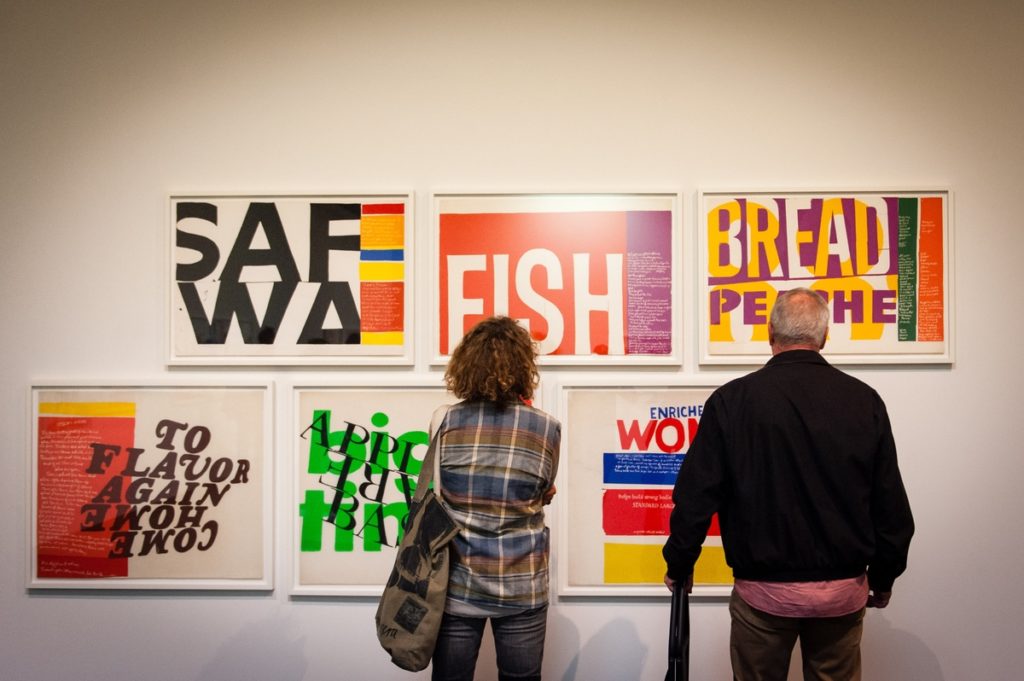ARTISTS David Bowden, Thomas Conrad, Baylis Glascock, James Grochowalski, Corita Kent, Colin McCahon, One King Productions, Michael Parekowhai, Scott Redford, Ed Ruscha, Jim Speers, Michael Stevenson CURATORS Robert Leonard, Simon Rees, Aaron Rose PARTNER Govett-Brewster Art Gallery, New Plymouth OTHER VENUES Govett-Brewster Art Gallery, 18 December 2015–3 April 2016; Ian Potter Museum of Art, Melbourne, 22 November 2016–26 March 2016 PUBLICATION texts Robert Leonard, Simon Rees, Aaron Rose
Sister Corita’s Summer of Love surveys the graphic art of Sister Corita Kent (1918–86), an unsung figure in pop art. Corita was a Roman Catholic nun. She lived and worked at the Immaculate Heart of Mary, in Los Angeles, from 1936 to 1968, heading their art department from 1964 to 1968. In the 1960s, she became famous for her screenprints, with their graphic treatments of texts, in bold, often fluoro, colours.
Corita was inspired by Andy Warhol. After catching his breakthrough show of Campbell’s Soup Can paintings at LA’s Ferus Gallery in 1962, she looked to the shelves of her own local supermarket, Market Basket, for inspiration. For instance, several prints famously drew on the packaging for Wonder Bread, making an analogy between this American staple and the Host.
Throughout the 1960s, Corita détourned the familiar languages of advertising and packaging, road signs and slogans, and quoted politicians, philosophers, and poets, pop songs and scripture, to forge her own messages of joy, faith, and love. Her work scrambled the sacred and the secular, finding religious import in the language of corporate-capitalist-pop America.
Corita’s approach was informed by the reforming imperatives of the Second Vatican Council (Vatican II), which sought to make the Roman Catholic Church more relevant to contemporary society. Through it, the Church advocated changes to traditional liturgy, notably conducting Mass in vernacular languages, instead of Latin. In America, the Church’s adoption of English underpinned Corita’s playful appropriation of colloquial language.
Caught up in the counterculture spirit of the times, Corita became increasingly political in the late 1960s, with works supporting the civil-rights movement, protesting the Vietnam War, and lamenting the assassinations of American political leaders.
Corita was a prominent figure in the 1960s. LA Times chose her as one of their ‘Women of the Year’ and Harper’s Bazaar included her in their ‘100 American Women of Accomplishment’. In 1967, she also appeared on the cover of Newsweek under the banner ‘The Nun: Going Modern’. But fame would bring a backlash from LA’s archbishop James Francis McIntyre—a Vatican II resister. In 1968, Corita left Immaculate Heart and relocated to Boston, where she continued to work. Her 1971 Rainbow Swash gas-tank mural remains one of the city’s most loved landmarks.
In addition to Corita’s screenprints, our show features documentary films that offer a rich context for her work. These include Baylis Glascock’s Mary’s Day 1965, which documents one of her art-directed ‘happenings’ at Immaculate Heart.
In its first showing, at the Govett-Brewster Art Gallery, Corita’s work was also supplemented with works by Colin McCahon, Ed Ruscha, Marco Fusinato, and Wellington Media Collective. In Wellington, it is supported with works by McCahon, Ruscha, Michael Parekowhai, Jim Speers, Scott Redford, and Michael Stevenson, and Christian videos featuring kinetic typography.
Thank you to Sister Corita Art Center and Immaculate Heart Community, Los Angeles.





































































































































